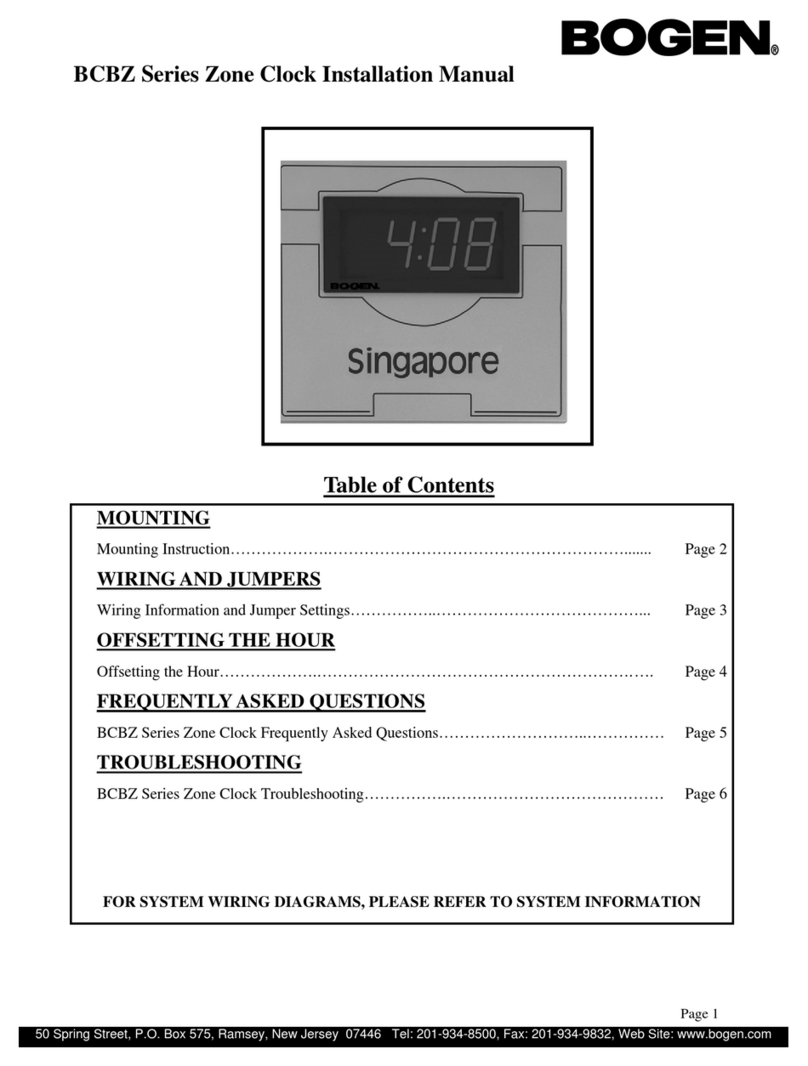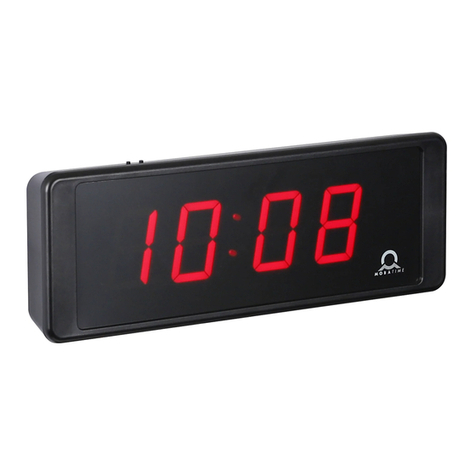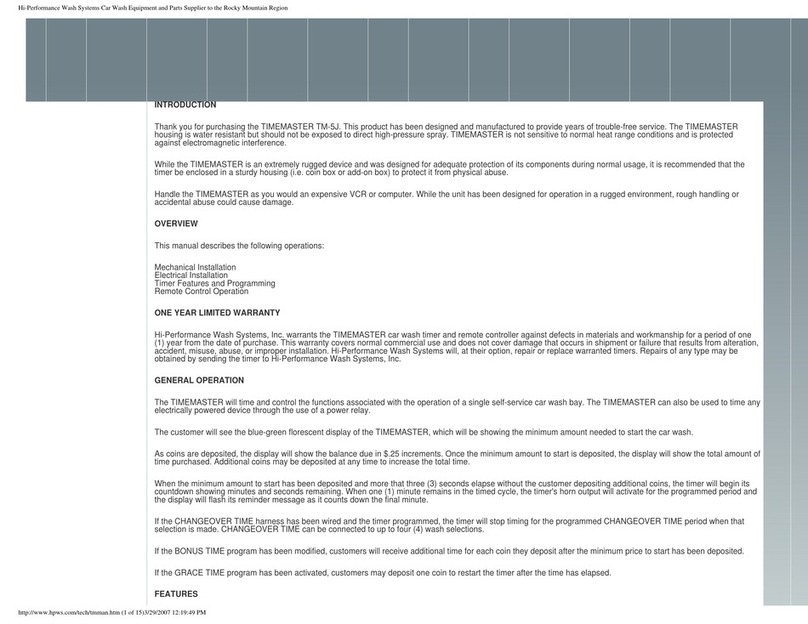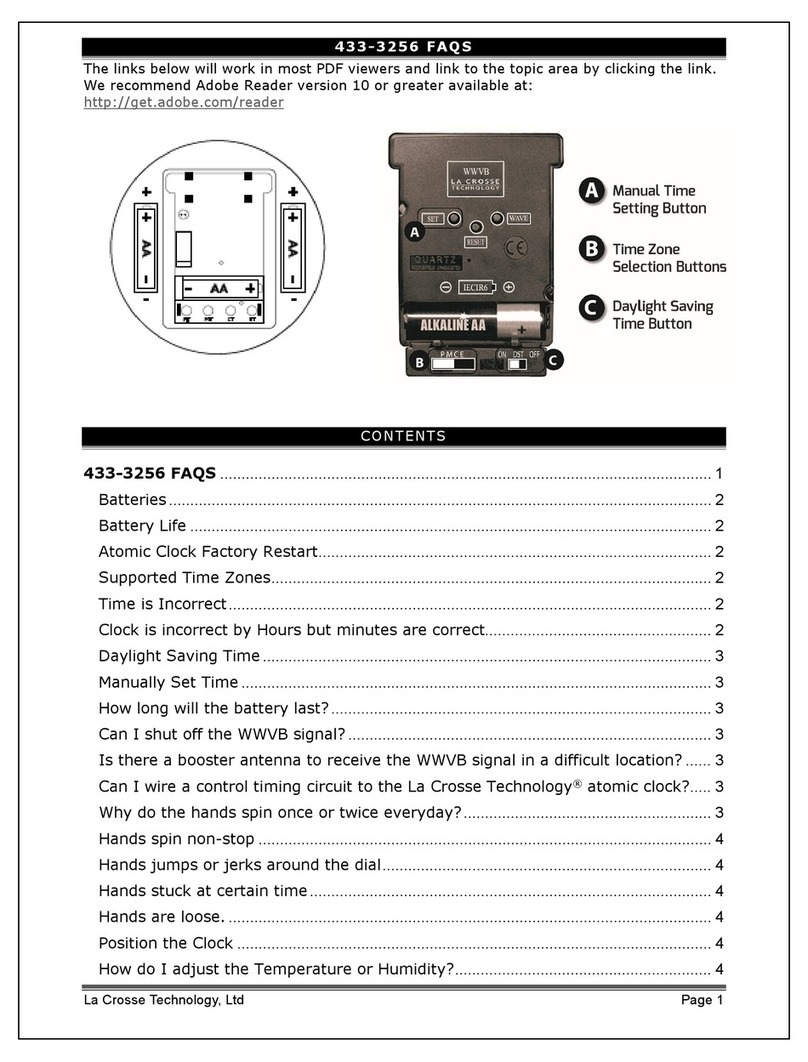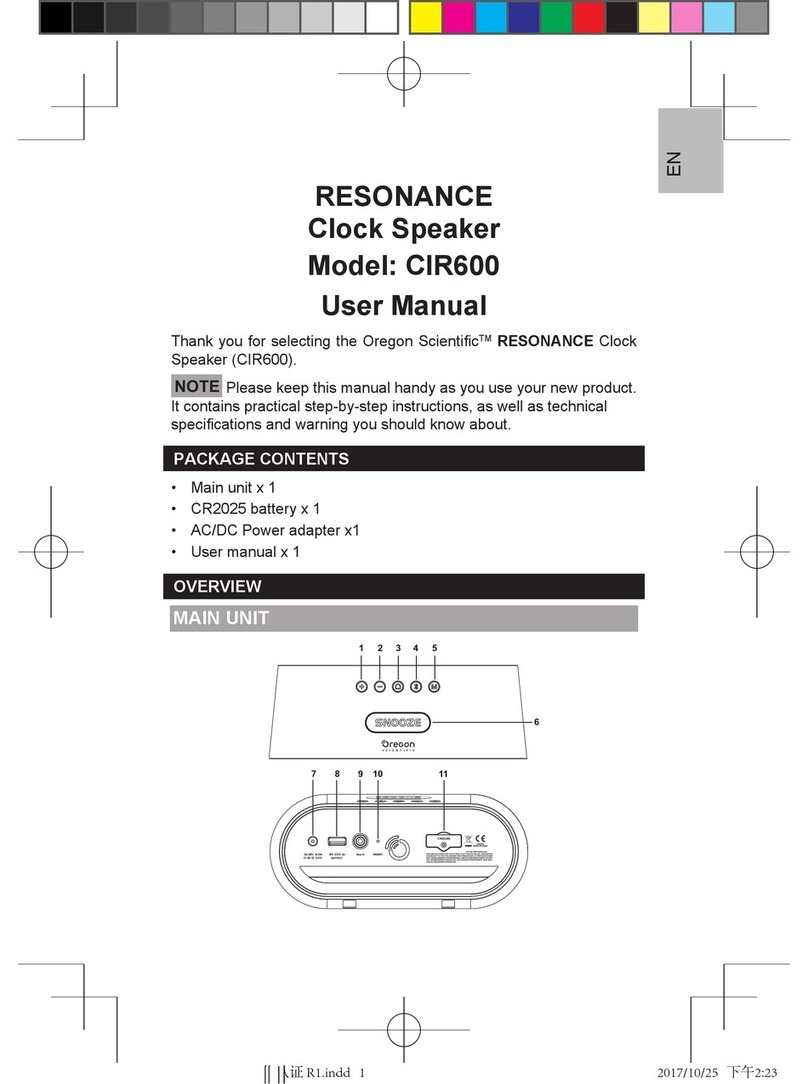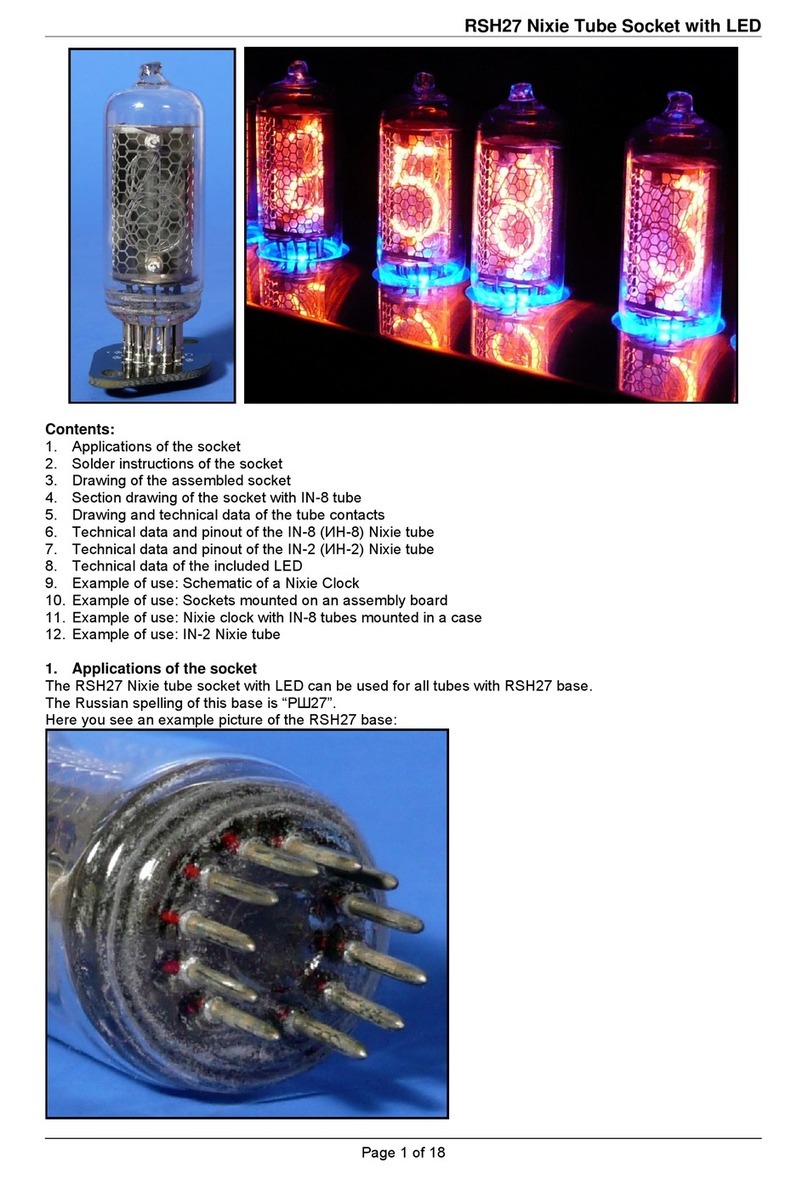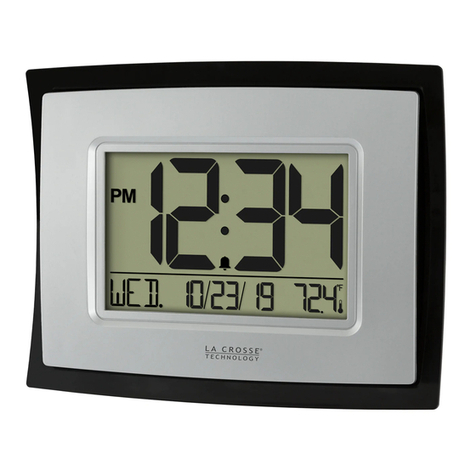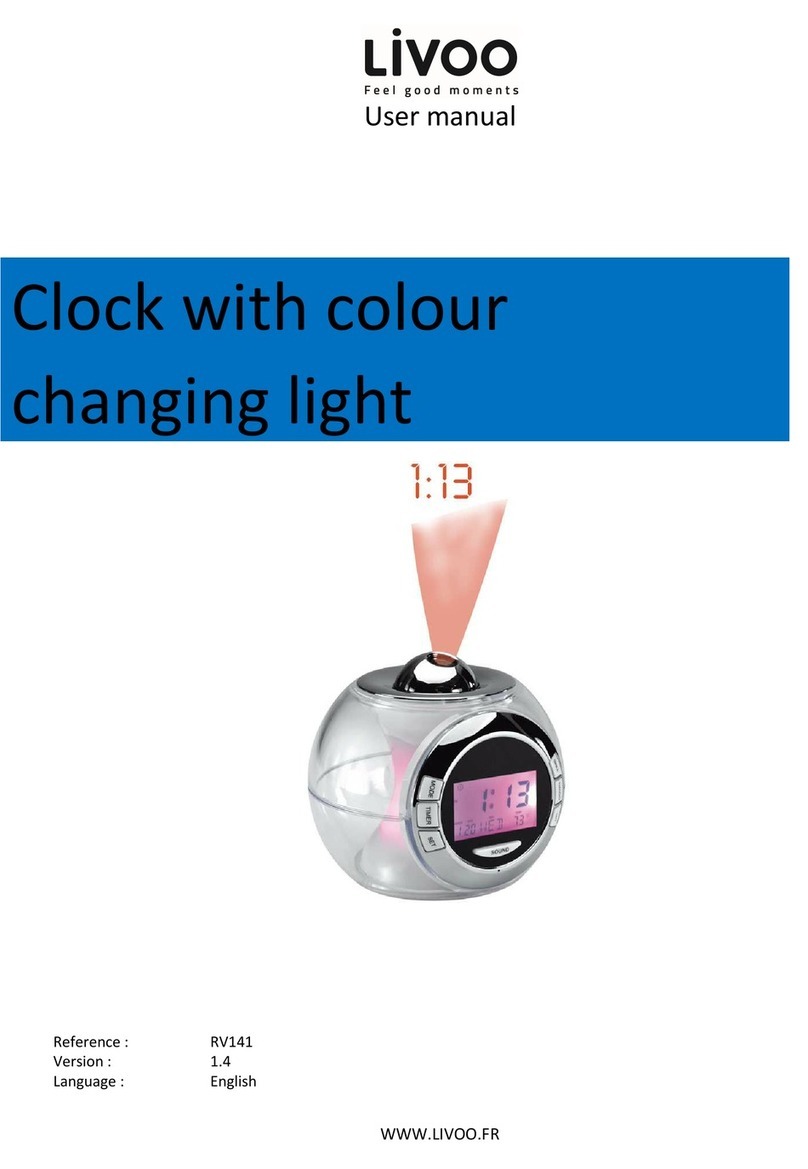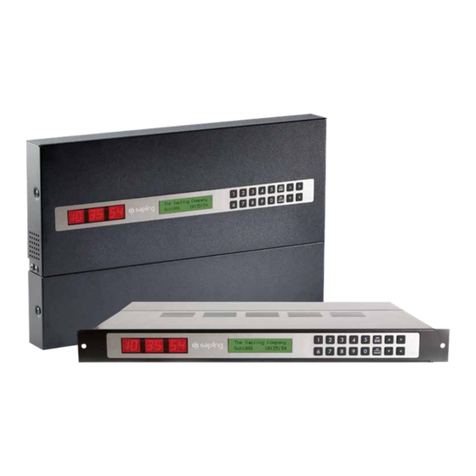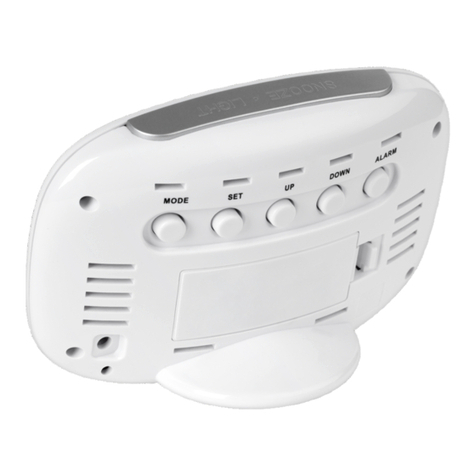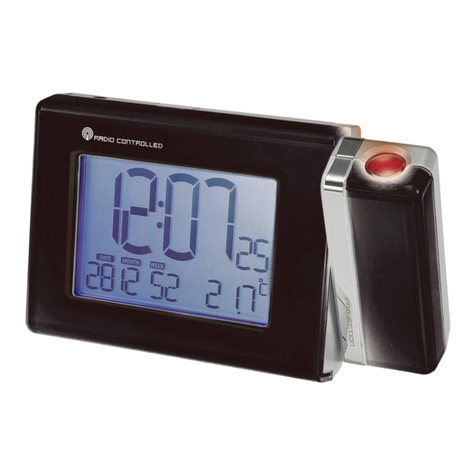euclid The Time Traveler's Clock User manual

THE TIME TRAVELER’S
CLOCK
The Project’s History and User Manual
Euclid Laboratories, Inc. -- Teaticket, MA

The Time Traveler’s Clock User Manual
“A Man with a watch knows what time it is. A man with two watches is never sure.”
--Lee Segall
“A man with three clocks is more sure than a man with two clocks.”
--Tim Van Baak
Table of Contents
Description and Background of the Time Traveler’s Clock, the “TTC”
•Description of the TTC Functional Modules
oGPS Receiver and Clock
oCesium Reference
oSilicon Receiver and Clock
oHamilton 21 Marine Chronometer
oGPS and Silicon Clock Display Panel
oUTC Navigational Time
•Origin of the TTC
oHow Did This Project Begin?
oWhy Do You Need a Time Traveler’s Clock?
oWhat if Time Travel is Impossible?
•History of Prototypes
oCesium Breadboard Prototype
oPyramid Cesium CSACGPSDO Prototype
oWinding Mechanism
oCube Box Rubidium Prototype
oMetal Cube Box Final Prototype
•How the TTC Works
oMarine Chronometer Advantages and Deficiencies
oGPS Clock Advantages and Deficiencies
oSilicon Clock Advantages and Deficiencies
oAtomic Reference Advantages and Weaknesses
oServoSync Design Evolution
Installation and Connections
•What’s Included
oThe Time Traveler’s Clock
oTiming Printer and Supplies
oMain Power Battery, Charger, and Connecting Cable
oBackup Battery Charger

oGPS Antenna
•Connections
oMain Power Input
oBackup Battery Charger Input
oGPS Antenna Input
oCesium 10MHz Output
oCesium 1pps Output
oGPS 1pps Output
oChronometer Tick Output
oTiming Printer
•Initial Setup
oConnecting the Power Supplies
oConnecting the GPS Antenna
oWinding and Setting the Chronometer
Normal Operations
•Daily Operation
oReading Times from the Display Panel
oReading Time and Winding Reserve from the Chronometer
•Time-keeping Verification
•Servo Controls
oServoSync
oRate Atomic and Rate Error Measurement
oRate Now
oSet RTC
•Winding Controls
oWind Now
oAutoWind
oManual Winding
•Other Control Panel Indicators and Buttons
•Printer
oNormal Operation
•Metal Cube Case Operation and Alternate Configurations
Maintenance Operations
•Setting the Silicon Clock by GPS
•Warm Resetting the Electronics
•Cold Resetting the Electronics
•Changing the Printer Paper

•Locking the Chronometer for Storage or Shipment
Appendices
•Schematic Diagram
•Description of the Circuit Operation
•Firmware

Description and Background of the TTC
Description of the TTC Functional Modules
GPS Receiver and Clock
The most precise and accurate time signal currently available on Earth is from the global
constellations of navigational satellites, such as GPS (US), Glonass (Russia), Beidou
(China), and Galileo (European Union). To provide position data to GPS receivers, the
satellites contain cesium atomic clocks which are continuously monitored and adjusted
by their respective countries. A GPS timing receiver can provide time to within as little
as 10 nanoseconds as long as it has at least four satellites in view. When satellite
reception is lost, the GPS timing receiver goes into “holdover” mode, in which it uses an
internal quartz oscillator to maintain time. In holdover mode a GPS timing receiver by
itself can maintain time to within 100 parts per billion, or a few seconds per year.
Cesium Reference
The cesium reference oscillator is known as a “chip-scale atomic clock” (CSAC). In the
CSAC, the oscillations of an isotope of cesium provide a “Stratum 1” 10 megahertz
reference signal. This signal stabilizes the GPS receiver so that the clock will operate at
the highest possible precision when a GPS signal is not present. The cesium CSAC is
accurate to 1x10-11, which translates to less than a millisecond per year.
Silicon Receiver and Clock
An independent electronic clock is incorporated which utilizes a silicon real-time-clock
(RTC) chip to provide time in case the GPS signal is unavailable and the CSAC atomic
clock fails or runs out of power. The RTC chip contains a temperature-compensated
quartz oscillator accurate to within a few minutes per year. The RTC chip will operate
independently from all the other systems by means of a lithium cell for several years.
It’s time and date are displayed on the display panel, which panel must be powered on,
at least temporarily, to read the time).
Hamilton 21 Marine Chronometer
Before the advent of radio time signals and portable quartz clocks, ships at sea utilized a
highly precise mechanical clock known as a chronometer to ascertain the ship’s
longitude. Chronometers sufficiently accurate to provide navigational time at sea were
first developed in the late eighteenth century by John Harrison. Over many years the
design of marine chronometers advanced, culminating in the Hamilton Model 21 Marine
Chronometer, developed during World War II by the Hamilton Watch Company in
Lancaster, Pennsylvania. The Hamilton chronometer was an improvement of
chronometers manufactured in Switzerland.
The US Navy and US Army used these chronometers until 1985, when they were
replaced by quartz instruments. The Hamilton 21 has a typical rate stability of one part
per million, equivalent to less than a minute per year. Generally marine chronometers
are provided to the user with data on when it was set to correct time and how much the
time can be expected to vary per day (the rate error). For navigational use, the user

must calculate the actual current time using the rate error and the number of days since
the chronometer was set to correct time.
The TTC contains a servo mechanism which provides a mechanical twisting motion to
the chronometer once per second to keep the chronometer synchronized with the GPS
timing receiver (which in turn is stabilized by the cesium CSAC). Thus, the GPS clock, the
cesium frequency reference, and the Hamilton chronometer are kept in resonance, and
the chronometer will remain as accurate as the GPS and atomic references.
The Hamilton 21 chronometer in the TTC is equipped with an electronic winding system
that winds the chronometer each hour to a consistent state of winding.
In order that precise time could be calculated from the Hamilton chronometer even if
the GPS and atomic references are not functioning (for example, if electrical power has
been lost for longer than the backup batteries will maintain operation), the natural rate
of the chronometer is measured once per day for a period of thirty minutes (at
midnight), and the deviation of the mechanical clock from the GPS and atomic
references is measured and printed out on the external printer. The user will thus have
the best possible knowledge of the rate error of the chronometer, and the precise
navigational time can be calculated from the number of days since it was last
synchronized and the average rate error per day.
Figure 1: Hamilton 21 Marine Chronometer
GPS and Silicon Clock Display Panel
The TTC has an electronic display panel which indicates the UTC time, date, latitude, and
longitude from the GPS clock as well as UTC time and date as maintained by the silicon
RTC clock.

Figure 2: GPS and RTC Display
UTC Navigational Time
There are many standards for time and date. Besides the standard local time zones,
there is a basis time known as Coordinated Universal Time (UTC). UTC is defined as the
time at the zero meridian which passes through Greenwich, UK. It is regulated by an
international committee, the International Time Bureau. Periodically, leapseconds are
added (or subtracted) from UTC in order to keep it more or less synchronous with
Earth’s rotation relative to the stars. Since UTC is always within one half second of the
Earth’s rotation, it is the preferred time standard to be used for navigation. For that
reason, the TTC uses UTC in all its displays and on the Hamilton chronometer.
Origin of the TTC
How Did This Project Begin?
After discovering and rebuilding the Time Viewer originally constructed by Leonardo; da
Vinci, the present inventor saw the need for a navigational clock for time travelers. It
may be true that Leonardo traveled to America in the 1940s, that he wanted to return
to Milano in 1478, and that he built the Time Viewer in order to learn the future
technology needed to construct a time-traveling machine. We know that Leonardo did
remain in Italy for the rest of his life. Could it be that he couldn’t navigate in time
anymore, since he lacked a chronometer? If the present inventor is ever able to build a
time-traveling machine, he would want to carry with him the most reliable possible
chronometer. So, first things first: the inventor turned his efforts to creating that
timekeeper.

Figure 3: Leonardo’s Time Viewer
Why Do You Need a Time Traveler’s Clock?
Imagine you’re traveling in time and space. Just like navigators of old, you’ll want to
have some “bearings” back home, so you can return or go to a new destination. Time
will essential to navigation, and we can assume that UTC will always be a good time to
know.
But, you never know—you might end up in the past when there was no GPS (the atomic
CSAC will keep you navigating); or, you might end up before there was electricity (you
can always wind your chronometer manually, and use the printed data to know the
corrections you’ll need to apply to the time that the chronometer displays). You might
travel to a time near the present when you can find electricity, but the GPS system isn’t
operational. You might travel to the future when the time standards and navigational
systems are completely different from what we have now (but you’ll be able to find
some form of electricity to keep your batteries charged to maintain your GPS internal
clock and your atomic-stabilized chronometer.
Eventually, the sands of time may cause the GPS and CSAC systems to fail, but you’ll be
left with your silicon RTC clock. And, in the end, you’ll still have your Hamilton marine
chronometer that you can keep winding for a long time (they have proven to be very
reliable for many years of operation). Make sure you wind it every day.
What if Time Travel is Impossible
It’s possible that time travel, either to the past or the far future won’t turn out to be
possible. So, the discerning individual would want to be able to navigate by land, sea, or
air via GPS, or using a sextant and their atomic clock, or a backup silicon chip clock, or

even just their mechanical chronometer. The TTC has you covered for any imaginable
eventuality. (And, if you’ve spent a lot of money on your yacht or aircraft, you’d
certainly want to have the absolute, ultimate, most-reliable timekeeper available.)
History of Prototypes
Cesium Breadboard Prototype
The first experimental design was constructed with a Hamilton 21 chronometer, a
Microchip/Jackson Labs cesium chip-scale atomic clock (CSAC) (later used in the MCB
Prototype), a ublox GPS evaluation kit (EVK-M8T), a Maxim DS3231 real-time clock (RTC)
chip, and a servo mechanism to rotate the chronometer by a small amount (about one
half degree of arc) following the seconds pulses from the GPS and CSAC.
This prototype was used to determine if it was possible to resonate a mechanical
chronometer, how much motion would be required, and to refine the displays for time
from the GPS and the RTC. A circuit was incorporated to allow re-setting the RTC from
the GPS whenever desired.
Additional problems to be worked out were an automatic winding system, a backup
battery array, and the rotational suspension system for the Hamilton chronometer. The
circuits were constructed using multiple Arduino Nano microcontrollers, breakout
boards, and solderless breadboards. The gimbals of the Hamilton chronometer were
mounted to a cradle mounted on a large, thin ball bearing and rotated using a high-
torque digital servo motor. Solutions to most of these problems were worked out,
though reliability problems persisted with power supplies and the winding system. In
addition, the full-circle ball bearing prevented the chronometer being rotated upward
for convenient manual winding.
Figure 4: Cesium Time Traveler’s Clock Breadboard
Winding Mechanism
The mechanism which continually winds the chronometer required considerable
development. Winding the chronometer requires substantial torque.The state of wind

must be periodically measured to determine if winding is required. As the chronometer
runs down, the winding input stem must be allowed to rotate backwards, so the
chronometer may continue operation. Finally, provision must be made for manually
winding the chronometer.
The successful winding mechanism uses a titanium-geared radio-control servo motor
fitted with a drive pinion. The drive pinion is driven alternately clockwise and
counterclockwise by the servo motor. The Servo Drive Pinion is constantly meshed with
the Winding Rack, which is driven back and forth by the Servo Motor. The Winding Rack
engages a Winding Gear. The Winding Gear rides on the Sinding Spindle, which has a
square opening on its upper end to engage the winding stem of the chronometer.
In order that the back-and-forth motion of the Winding Rack does not force the Winding
Spindle backwards (which would damage the chronometer), a One-way Clutch is
pressed into the Winding Gear and rides on the hardened surface of the Winding
Spindle. When each winding cycle is completed, the Winding Rack is returned to its
“home” position. In the home position, the rack has a portion of its teeth removed to
disconnect it from the Winding Gear, allowing it to turn backwards as the chronometer
unwinds.
The State-of-wind Potentiometer, coupled to the Winding Spindle by a timing belt,
measures the degree to which the chronometer is currently wound. Complete winding
requires approximately eight turns, so a 10-turn potentiometer is used to follow the
Winding Spindle in a 1:1 ratio.This potentiometer is read by a microcontroller which
controls the winding process.
The bottom end of the Winding Spindle has a 3mm square shaft protruding to allow the
user to apply a manual winding key.
Every hour, the condition of the State-of-wind Potentiometer is measured by the
microcontroller and the Servo Motor is actuated back-and-forth until the chronometer
is fully wound.

Figure 5: Winding Mechanism
Pyramid Cesium CSACGPSDO Prototype
The next generation of prototypes was built in a pyramidal shape with proportions from
the Great Pyramid of Giza. The bottom of the enclosure was black acrylic with a window
for the electronic displays, and the upper cover was clear acrylic to allow viewing of the
controls and chronometer. The thermal printer to record the natural rate of the
chronometer was added to the rear panel, and backup batteries (Saft thionyl-chloride D
cells) were fitted inside the base. The “tick” signal output from the mechanical
chronometer needed to operate the rating circuit and printer was changed to a simple
contact-closure mechanism which is available in a few of the Hamilton 21 chronometers
which were made in the last century. While only a few of these exist, the mechanical
contact closure is much superior to optical and audio sensors that were evaluated to
pick up the “ticks” of the chronometer.
In the Pyramid Clock, the atomic reference was a Jackson Labs cesium-CSAC GPS
Disciplined Oscillator module, which incorporated a cesium reference oscillator phase-
locked to the GPS chip. A separate display was run from this module to display the date,
time, latitude, longitude, and operational characteristics of its GPS and the CSAC. The
GPS clock was a ublox EVK-M8F module, which provided date, time, longitude, and

latitude independently from that supplied by the CSAC GPS Disciplined Oscillator. The
Maxim RTC system was unchanged except for software refinements.
The gimbal support and servo system were like those on the Cesium Breadboard
Prototype. The problem of not being able to manually wind the chronometer without
disassembling the housing remained and needed to be fixed.
Figure 6: Pyramid Time Traveler’s Clock
It was found that a redundant GPS systems was not needed, because a CSAC GPS
Disciplined Oscillator (either cesium or rubidium) provided date, latitude, longitude, and
time from the atomic reference, maintaining accuracy to a millisecond per year.
Cube Box Rubidium Prototype
The inventor decided that the pyramid enclosure, while having an interesting
appearance, was not very space-efficient, and he decided to go with a more traditional,
cubical, mahogany box, like what has been traditionally used for marine chronometers,
but increased in size (having more internal volume and a smaller footprint than the
pyramid). The cube box had a lower section (about 2/3 of the height) that enclosed all
the circuits, batteries, and chronometer. A display panel was mounted behind the
chronometer, and a row of display lights and switches was placed across the front of the
chronometer. The upper section of the box was hinged and latched to the lower
section, covering the chronometer and controls. It allowed the user to see all the
displays, switches, and chronometer through a clear window. Above the upper section
was a hinged lid and latch to close the box.
In this prototype the atomic reference was a stand-alone rubidium miniature atomic
clock (MAC) from Jackson Labs. This oscillator was calibrated with a GPS-disciplined
reference clock before use. The 10MHz output of the MAC was connected to an input
on the GPS module (a ublox EVK-M8F) to supply the chip with a precision time base to

allow the GPS to maintain accurate time during “holdover”, when a GPS signal is not
available. This simpler design works as well as the cesium CSAC/GPS-Disciplined-
Oscillator module, is less expensive, and is less complicated.
In the Cube Box, the chronometer gimbals were mounted on an aluminum lazy-susan
bearing that was cut away at the rear; this opening allowed the chronometer to be tilted
upward for manual winding. The lazy-susan bearing, however, had too much clearance
between its races, resulting in unstable oscillations of the servo drive.
The chronometer-rate printer was mounted in a separate enclosure and connected by a
cable to the rear panel of the box.
In addition to the GPS Antenna connection on the rear panel, SMA connectors supplied
the MAC 10MHz reference frequency, the MAC 1-pulse-per second (1pps) signal, the
GPS 1pps signal, and the chronometer seconds-tick signal. A push-on connector was
provided for the rate printer.
Refinements needed to this design included improving the reliability of the automatic
winding system, providing a more precise gimbal-support bearing, aesthetics, and
reversion to a cesium-based atomic reference.
Figure 7: Cube Box Traveler’s Clock
Metal Cube Box Final Prototype
The next prototype incorporated a fully-machined anodized aluminum enclosure in
place of the mahogany box following the same design and dimensions. The gimbal-

support bearing was changed from the lazy-susan bearing to a precision V-groove
circular rail with four support bearing rollers; the rear part of the rail was cut away to
allow the chronometer to be rotated for winding. This bearing arrangement was more
precise, so the servo synchronizing mechanism performed much better.
The displays were simplified to two LCD displays: one showing the GPS date, time,
latitude, and longitude and one showing date and time from the RTC. No separate
display was used for the CSAC, as it operates only to supply the 10MHz precision
reference frequency.
The rubidium MAC was replaced with the cesium CSAC used in the Cesium Breadboard
Prototype. Otherwise, the MCB Prototype was like the Cube Box Prototype and used
the same electronic hardware and firmware. The operational scheme remained with
the GPS module being fed a precision 10MHz frequency reference from the CSAC to
ensure long-term accuracy during holdover.
Figure 8: Metal Cube Box Time Traveler’s Clock (rendered with clear case)
How the TTC Works
Marine Chronometer Advantages and Deficiencies
The Hamilton 21 Marine Chronometer represents the height of development of
portable mechanical clocks for navigation. The basic design, developed by several
companies in Switzerland (Zenith, Ulysse-Nardin, Ditisheim, among others) includes a

wooden box, gimbals, chronometer case, and a clockwork which incorporates a fusee
mechanism for near-constant winding force as the mainspring winds down, a detent
escapement, and a temperature-compensated balance wheel fitted with a helical
hairspring.
When the US Navy realized the upcoming need for thousands of such chronometers in
the years prior to World War II, the only company which could fill the need was
Hamilton Watch Company of Lancaster, Pennsylvania. Hamilton could meet the need if
the basic design of a Ulysse-Nardin chronometer was exactly copied, except for the
balance wheel assembly. Hamilton had developed a better way to create a
temperature-compensated balance wheel that would not require the time-consuming
and laborious process of regulation that was required by the Swiss-pattern
chronometers.
Figure 9: Ulysse-Nardin Marine Chronometer, Predecessor to Hamilton 21
By making the balance wheel an unbroken ring of stainless steel supported by a simple
two-spoke arrangement made from Invar (a metal alloy with near-zero change in
dimension with temperature change), a Hamilton could manufacture a balance with
built-in temperature compensation not requiring many days of regulating. Hamilton
produced about 10,000 such chronometers prior to and during the war, and these were
found to be the most reliable and precise chronometers manufactured until that time.
The advantages of a mechanical, manual-wind chronometer are its reliability and
trustworthiness. As long as the chronometer is wound each day, accurate time is

assured. Each instrument could be regulated to keep time within a second per day,
and—more important—its deviation from perfect time would be a very precise value
which would not change over the life of the chronometer. Each chronometer supplied
to the Navy (and, also, to the US Army Corps of Engineers) came with a record telling
when it was set to time as well as its measured error per day. From these data a
navigator could subtract the daily error multiplied by the number of days from the
currently displayed time, resulting in a very accurate “corrected” time for navigation.
Weaknesses of a mechanical chronometer include the need for continual winding; and,
if the instrument is allowed to run down, then all knowledge of time will be lost. Also,
while physically very robust, these instruments have to be handled with great care in
order not to upset the timekeeping. On larger ships the navigator kept two or three
chronometers for redundancy.
During normal operation, the TTC keeps the mechanical chronometer synchronized to
GNSS or atomic precision by means of a servo-mechanical system. It has been found
that a very small rotation of the chronometer every second will quickly cause the
chronometer to become synchronized to that rotation, because the escapement and
balance system in the chronometer become resonant with the applied mechanical
rotation. It is this resonance that affords the chronometer the ability to maintain
“perfect” time as long as the atomic or GNSS signals are present. If those signals are no
longer present, such as if all power is lost for an extended period, the chronometer will
revert to its natural rate. During normal operation, once per day, at midnight UTC, the
servo synchronization is turned off so that the natural rate of the chronometer can be
measured versus the atomic or GNSS standard, and that error is printed on a paper
tape.
Should the electronic clock systems in the TTC be lost, the user can use these historical
measurements to calculate the best time for navigation by applying the daily error to
the time read on the chronometer, as was done in the past, before satellite and atomic
standards.

Figure 10: Hamilton 21 Marine Chronometer
GPS Clock Advantages and Deficiencies
The various global navigational satellite systems (GNSS systems, including the US GPS,
Russia’s Glonass, Europe’s Galileo, and China’s Beidou) rely on very-high precision time
keeping in order to allow a receiver to calculate its own position. Each satellite
broadcasts its current time and its ephemeris (the parameters of its orbit). The receiver
must then compare the times received from multiple satellites, correct for relativistic
timing frame differences, and perform a complex calculation to “multilaterate” its own
position on earth. In the process, the receiver also calculates the current time to a very
high degree of accuracy, on the order of nano- or micro-seconds. A timing-rated
receiver can provide true time accurate to within a few tens of nanoseconds.
When provided with an external frequency reference, the GNSS receiver can maintain
the time (“holdover”) even if satellite signals are lost. By itself, the uBlox M8F receiver
has a holdover precision of 1 x 10-7, or 8 milliseconds per day. If an atomic reference
signal is supplied, then the holdover precision will be equal to the precision of the
atomic reference signal (in the TTC, 1 x 10-10, equivalent to a few milliseconds per year).
Since these satellite signals are available almost anywhere on earth, the time provided
by a GNSS receiver is the time used for most scientific, civil, and navigational purposes.
Why would a user need to use precise time for navigation, given that he has a GNSS
receiver giving precise latitude, longitude, and altitude data? The answer is that GNSS
systems can be jammed or spoofed, resulting in inaccurate location calculations. By
keeping a reliable clock continually set to known good GNSS time, a navigator may use a
sextant and navigational number tables to calculate his position, even if the GNSS
signals are incorrect or unavailable.
The TTC can be used for navigation because it has multiple time references, including
atomic, quartz, and silicon-based clocks in addition to its mechanical chronometer.

When GNSS time signals are available, the quartz, silicon, and mechanical clocks are
kept synchronized to satellite time.
Silicon Clock Advantages and Deficiencies
One of the redundant clocks contained in the TTC is an integrated-circuit chip (Dallas
DS3231) which contains a temperature-corrected quartz oscillator of its own and an
extremely-low power microprocessor which maintains correct time, even if it’s main
power supply is lost, using a small backup battery. The lifetime of the backup battery is
at least ten years, and it is only used when the normal power supply is not available.
This integrated-circuit clock is not as accurate as an atomic or GPS clock, but it can serve
as a timing reference if all else is lost, and it is a redundant clock to supplement the
other quartz, atomic, and mechanical timekeeping systems. The integrated-circuit clock
in the Dallas DS3231 chip is specified to be accurate to within one minute per year;
DS3231 chips used in the TTC are individually tested and calibrated to achieve
significantly improved timekeeping, on the order of seconds per year.
Figure 11: Real-time Clock with DS3231 Silicon Integrated Circuit
Atomic Reference Advantages and Weaknesses
TTCs use atomic frequency standards based upon the oscillations of cesium or rubidium
atoms. These are the most precise reference standards available that can be used in
portable equipment. The “Miniature Atomic Clock” (MAC) and “Chip-scale Atomic
Clock” (CSAC) technology was developed by Jackson Laboratories.
The current state-of-the-art devices are cesium CSAC modules such as the one used in
the latest MCB version of the TTC. The signal from this module, a 10 MHz reference, is
supplied to the GNSS timing receiver so that if satellite signals are not available, the
receiver will go into “holdover” mode with the precision of an atomic clock. The cesium
CSAC modules have an accuracy of 1 x 10-10, which is equivalent to a few milliseconds
per year. In the TTC, this signal serves as the reference to not only the GNSS receiver,
but also to the mechanical chronometer by way of the servo synchronization system.
Atomic clocks require continuous electrical current to maintain their accuracy.
However, if power is restored after a temporary loss, the atomic clock module will re-
establish its operation according to the last stored tuning data and once again begin to
supply a stable reference signal to the GNSS receiver. During the time that the atomic
reference is lost, the GNSS receiver will revert to its own internal quartz reference,
which is precise to 1 x 10-7, or 8 milliseconds per day.

Figure 12: Cesium Chip Scale Atomic Clock Circuit Board

ServoSync Design Evolution
The conception of the Time Traveler’s Clock includes the means by which a mechanical
chronometer is kept in perfect synchronization with an atomic- or GPS-based time
signal. A very small rotary motion (on the order of +/- 0.5mm) applied to the gimbal-
mounted chronometer will cause the balance wheel and detent escapement to fall into
resonance with that motion. Several design problems needed to be solved in order to
make this system practical. A servo motor of the type used in robots and remote-
control models is driven by a microcontrollers to provide a back-and-forth motion, and
this motion is connected to the gimbals of the chronometer by means of a lever and a
linkage.
Two problems remained: how to mount the chronometer and its gimbals in such a way
that the chronometer can be rotated by this small amount; and, how to provide space
for the chronometer to be tilted forward so it could be manually wound. Three
successive designs were developed.
1. Ring-bearing Design:
The first design developed to impulse the chronometer back and forth in a rotary
direction used a thin-section ball bearing. A servo motor was linked to the rotary
carriage with a simple linkage to transmit the back-and-forth rotary impulse to the
chronometer gimbal rings. This design worked well, but the bearing, being was a
complete circle, would not allow the chronometer to be tilted forward for manual
winding.
Figure 13: ServoSync Mechanism with Thin Ball Bearing Design
Table of contents
